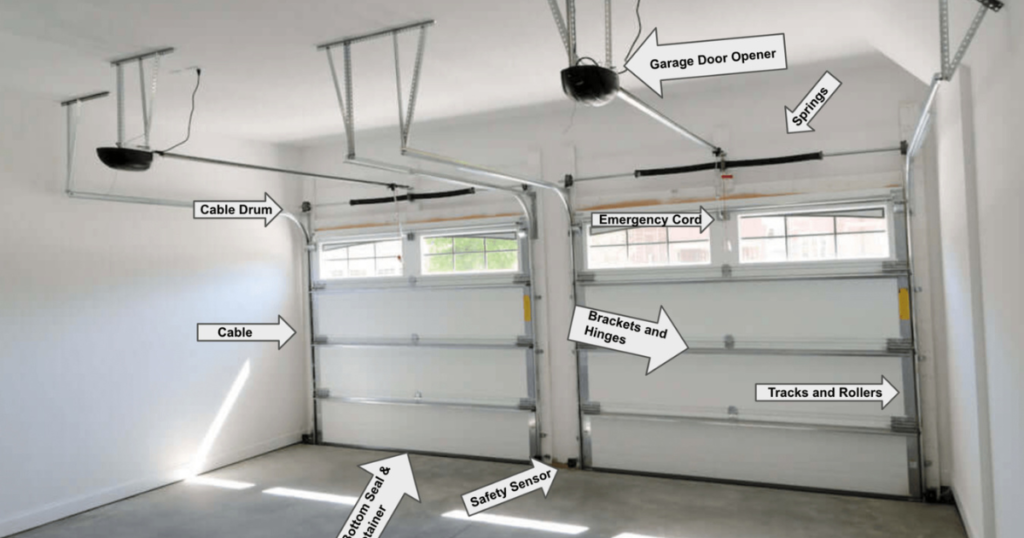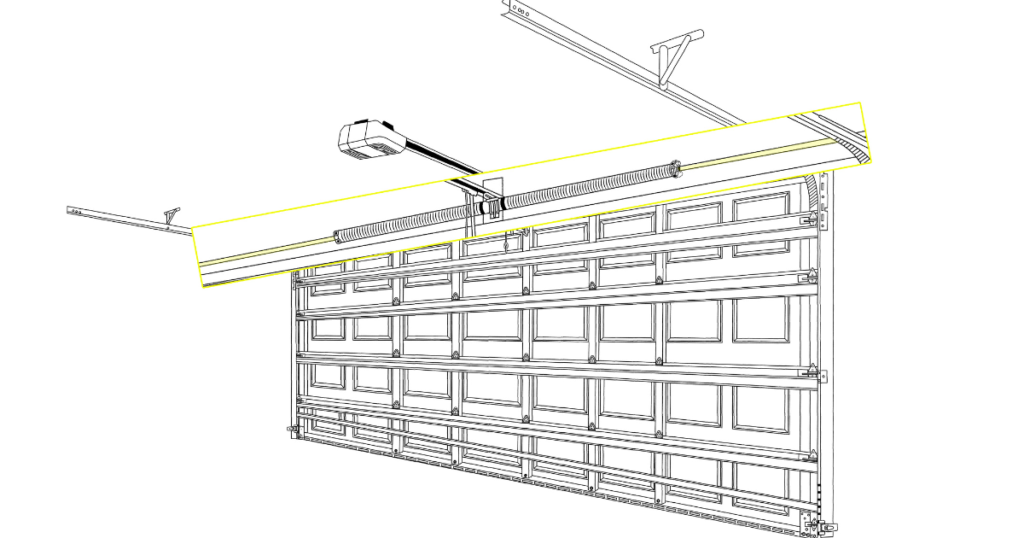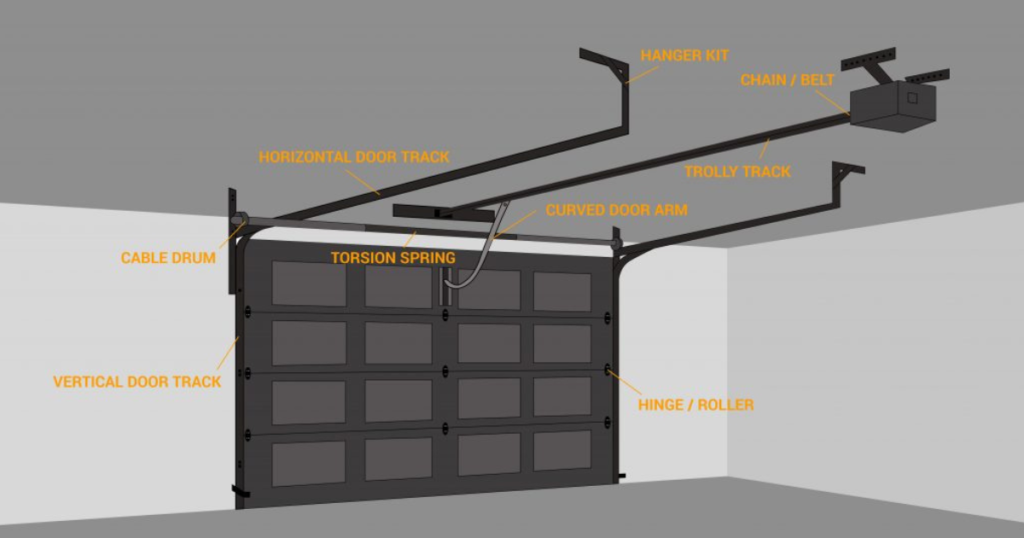Explore the anatomy of a garage door and learn about each component, from springs and tracks to panels and openers, for better maintenance and performance.
When did you last think about how your garage door works? The anatomy of garage door systems involves more than just panels and hinges. Understanding the structure and function of each part can help you maintain your garage better, diagnose problems early, and make smarter repair or replacement decisions.
This blog breaks down every component involved in a typical garage door system. Whether you’re a homeowner, contractor, or just interested in how things work, learning the full anatomy of garage door parts gives you the clarity you need.

From springs and cables to tracks and openers, we’ll provide a comprehensive look into how your garage door operates, how the parts interact, and what to watch for when wear and tear set in.
The Anatomy of a Garage Door Begins with the Panels
Exploring the construction of a garage door starts with the panels. These are the primary surface components that make up the door’s face and are typically the first feature anyone notices. However, their role goes far beyond just appearance.
What Are Garage Door Panels?
Garage door panels are the individual horizontal sections that are joined together to form the full height of the garage door. These sections are usually connected by hinges, which allow the door to flex and follow the curved track as it opens and closes. This flexibility is crucial to the door’s smooth operation.
Materials Used in Panels
Panels can be crafted from a variety of materials, each offering unique benefits:
- Wood: Offers a classic and customizable appearance, but requires more maintenance.
- Steel: Known for its strength and durability, steel panels are common in residential and commercial doors.
- Aluminum: Lightweight and rust-resistant, often used for modern or specialty designs.
- Composite Materials: A blend of materials that combine the look of wood with the strength of steel or other metals, often low-maintenance and durable.
Design and Features
Depending on the style of the garage door, panels may incorporate:
- Windows: To allow natural light into the garage while adding aesthetic appeal.
- Decorative Hardware: Such as handles or faux hinges, which can enhance the overall appearance.
- Insulated Layers: Panels can be built with insulation to improve energy efficiency and reduce noise.
Why Panel Condition Matters
Maintaining the condition of garage door panels is essential for several reasons:
- Functionality: Dents, warping, or corrosion can disrupt the door’s movement and strain the operating mechanism.
- Appearance: As the most visible part of the door, damaged panels can significantly affect curb appeal.
- Durability and Efficiency: Well-kept panels contribute to better insulation, improved weather resistance, and overall longevity of the garage door system.
Torsion and Extension Springs: The Heavy Lifters
The springs are the most critical components in the anatomy of garage door systems. These manage the weight of the door, making it easy to lift manually or by an opener.
Torsion Springs
Torsion springs twist to generate force. They’re mounted above the closed door and are preferred for their balance and durability.
Extension Springs
Found on both sides of the door, these stretch and contract as the door moves. While often cheaper, they can be less durable and pose higher risks if they fail.
Recognizing spring wear early prevents dangerous breakages and protects the rest of your garage system.
Tracks and Rollers: The Guiding Path
Garage door tracks are mounted on both sides of the door frame and along the ceiling. They create the path the door follows. The rollers, which are small wheels attached to the panels, glide within these tracks.
If the tracks are bent or blocked, or if the rollers are worn out, the door may jam or operate unevenly. Tracks must be aligned and lubricated to avoid straining other components.
Rollers are made of various materials, such as nylon, steel, and plastic. Quality rollers reduce noise and increase the system’s lifespan.
Cables and Drums: The Hidden Strength
The cables and drums, which support the springs, are less visible but vital to the anatomy of garage door systems. Cables run along the sides and are attached to the bottom of the door. They connect to drums, which are mounted to the torsion spring shaft.
As the door opens and closes, the drums wind and unwind the cables to lift or lower the door evenly. Frayed or damaged wires can lead to a dangerous system failure.
Routine inspection of these components can prevent sudden and costly breakdowns.
Hinges and Brackets: The Connective Support
Hinges connect the garage door panels, allowing them to bend as the door moves. Brackets hold everything in place and anchor the system to the walls and ceiling.
These parts endure regular motion and tension. If a hinge breaks, the panels can misalign. Loose brackets may cause the track or opener to malfunction. Regular tightening and lubrication are essential.
Choose heavy-duty steel hardware for durability, especially for larger or insulated doors.
The Opener System: Modern Convenience and Control

The garage door opener is the motorized system that lifts and lowers the door. It typically includes:
- A motor unit mounted on the ceiling
- A rail connecting the motor to the door
- A trolley that pulls the door
- Remote controls or smartphone integration
Some openers include battery backups, motion-sensor lights, and smart home compatibility. A malfunctioning opener might not mean the whole system is at fault. Understanding its relation to the rest of the anatomy of garage door systems helps in precise troubleshooting.
Sensors and Safety Features
Modern garage doors are equipped with photo-eye sensors that prevent the door from closing if something is in the way. These are mounted a few inches from the ground on either side of the door frame.
Test your safety sensors regularly to ensure they’re working correctly. Faulty sensors can lead to accidents or prevent the door from operating entirely.
Other safety features may include auto-reverse mechanisms and manual emergency release cords.
Regular Maintenance and When to Call Experts
Knowing the anatomy of garage door systems allows for basic DIY inspections, like checking for loose bolts, applying lubricant, and testing the balance. But when you encounter spring issues, loud grinding sounds, or off-track rollers, professional help is essential.
A maintenance plan that includes inspection, lubrication, and part replacement extends the life of your garage system and prevents emergency repairs.
Frequently Asked Questions
What is the strip around the garage door called?
The strip around a garage door is called weatherstripping or garage door trim. It seals gaps around the door to keep out drafts, water, dust, and pests, and also helps with insulation and noise reduction.
What are garage door sections?
Garage door sections are the individual horizontal panels that make up a sectional garage door. These panels are hinged together, allowing the door to bend and roll along tracks as it opens and closes.
What are the parts of a garage door?
The main parts of a garage door include the door panels, springs (torsion or extension), tracks, rollers, hinges, cables, and the opener system. Each component works together to properly lift, lower, and secure the door. Proper maintenance of all parts ensures smooth operation and safety.
What is the bottom part of a garage door called?
The bottom part of a garage door is called the bottom section or bottom panel. It often includes a weather seal that helps keep out water, debris, and pests. This part is also crucial for alignment and structural support.
What is the metal around the garage door called?
The metal around the garage door is typically called garage door trim or flashing. It can be made of aluminum or steel and provides a clean finish around the door frame. It also helps seal and protect the edges from weather and damage.
Conclusion
Understanding the anatomy of garage door systems is essential for every homeowner. It enables smarter maintenance, safer operation, and better communication with service providers when issues arise.
Each component plays a vital role in how the garage door operates. From springs and rollers to openers and safety sensors, the interplay of parts makes the entire system function smoothly and safely.
If you’re experiencing problems or want a professional to evaluate your system, trust the team at Rowlett Garage Door.
End Note
Rowlett Garage Door and Gate delivers uncompromised quality and outstanding value to every client. From complete new garage door installation to emergency garage door repairs, our team ensures that every project is handled with expert care and attention to detail. Our goal is to offer the most affordable, high-quality services available, ensuring customer satisfaction every step of the way.
Explore our full range of garage door services, including broken spring replacement and garage door spring repair. We proudly serve Rowlett and neighboring areas like Anna, TX, always upholding our commitment to reliability and affordability. To learn more about our mission and team, visit our About Us page. Our Q&A page provides helpful answers, and you can always reach out directly through our Contact Us form for personalized support. Rowlett Garage Door and Gate is your trusted partner in maintaining, repairing, and installing garage doors with unmatched dedication and care.
Rowlett Garage Door and Gates
5813 Cypress Dr, Rowlett, TX 75089, United States
+14699208704

